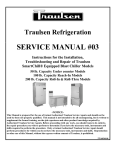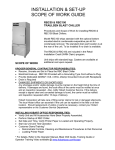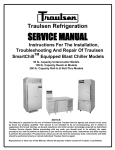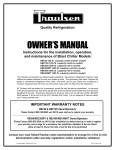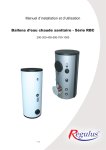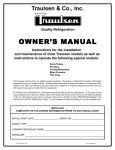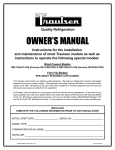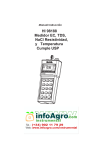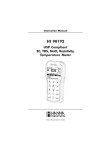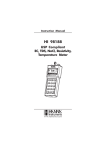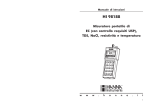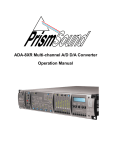Download Traulsen KROGER RBC50 User's Manual
Transcript
Traulsen & Co., Inc. Quality Refrigeration OWNER’S MANUAL Instructions for the installation, operation, and maintenance of all Blast Chill Models: Undercounter Model: RBC50 Reach-In Model: RBC100 Roll-In Models: RBC200 & RBC400 Roll-Thru Models: RBC200RT & RBC400RT This Traulsen unit is built to our highest quality standards. We build our refrigerators, freezers and heated cabinets this way as a matter of pride. This philosophy has made Traulsen the leader in commercial refrigeration since 1938. We thank you for your choice and confidence in Traulsen equipment and we know you will receive many years of utility from this equipment. All Traulsen units are placed on a permanent record file with the service department. In the event of any future questions you may have, please refer to the model and serial number found on the name tag affixed to the unit. Should you need service, however, call us on our toll free number, 800-825-8220 between 7:30 am and 4:30 pm CST, Monday thru Friday. It is our pleasure to help and assist you in every possible way. INSTALLER COMPLETE THE FOLLOWING INFORMATION PRIOR TO UNIT INSTALLATION INITIAL START DATE: SERIAL NO. MODEL TYPE: COMPANY/INDIVIDUAL NAME: INSTALLER: RBC DOC REV. 12/02 P/N 375-60180-00 TABLE OF CONTENTS I. The Serial Tag II. Receipt Inspection III. Installation a-Location b-Packaging c-Wiring Diagram d-Installing Legs or Casters e-Cord & Plug f-Electrical Requirements g-Proper Clearances h-Condensate Removal i-Remote Unit BTU Requirements j-Remote Unit Cut-Out Settings k. Sealing Roll-In/Roll-Thru Units l. Installing RBC50 Control Panel m. Attaching RBC400 Units Together IV. Care & Maintenance a-Cleaning The Condenser b-Cleaning The Exterior c-Cleaning The Interior d-Installing Printer Paper V. Other a-Service Agency Check & Start-Up b-On-Site Blast Chill Training c-Service Information d-Demonstrations e-Blast Chill Video f-Blast Chill Data Communications Kit VI. Blast Chill Operation a-Loading Food Into Pans b-Covering Foods Page 1 Page 2 VI. Blast Chill Operation (cont’d) c-Grouping Foods To Form Batches d-Maximum Load Per Batch e-Pan Placement In Unit f-Food Probe Placement g-Example Batches For RBC50 h-Example Batches For RBC100 i-Example Batches For Roll-In/Roll-Thru Models VII. Operating The Blast Chill Control a-Operating Modes b-Continuous Batching c-Probe Temperatures d-Lock Function e-Unlock Function f-Defrost Function g-Printout Data h-Resetting Date & Time i-Programming A New Batch j-Control Panel Configuration k-Probe Temperature & Alarm Warnings VIII. Understanding Printouts a-Current Data Printout b-Constant Chill Cycle - Batch Data c-Blast Chill Cycle - Batch Data d-72-Hour Data Log e-Food Probe Failure Warnings IX. Trouble Shooting Guide X. Wiring Diagrams XI. Warranty Information XII. Parts List XIII. Index Page 2 Page 2 Page 2 Page 2 Page 3 Page 3 Page 3 Page 4 Page 4 Page 4 Page 4 Page 5 Page 5 Page 6 Page 6 Page 6 Page 6 Page 6 Page 6 Page 6/7 Page 7 Page 7 Page 7 Page 7 Page 7 Page 7 Page 8 Page 8 Page 9 Page 9 Page 10 Page 11 Page 12 Page 13 Page 13 Page 13 Page 13 Page 13 Page 13 Page 13 Page 13/14 Page 15 Page 16 Page 16 Page 16 Page 17 Page 18 Page 19 Page 20 Page 21-24 Page 25 Page 26 Page 26 I. THE SERIAL TAG The serial tag is a permanently affixed sticker on which is recorded vital electrical and refrigeration data about your Traulsen product, as well as the model and serial number. This tag is located inside the door on the right interior wall of the cabinet. FORT WORTH, TX. SERIAL VOLTS MODEL Hz PH TOTAL CURRENT AMPS MINIMUM CIRCUIT AMPS MAXIMUM OVERCURRENT PROTECTION LIGHTS WATTS HEATERS AMPS AMPS REFRIGERANT DESIGN PRESSURE TYPE HIGH OZ LOW REFRIGERANT DESIGN PRESSURE TYPE HIGH OZ LOW 370-60294-00 REV (A) R R AW-03118 -1- READING THE SERIAL TAG • Serial = The permanent ID# of your Traulsen • Model = The model # of your Traulsen • Volts = Voltage • Hz = Cycle • PH = Phase • Total Current = Maximum amp draw • Minimum Circuit = Minimum circuit ampacity • Lights = Light wattage • Heaters • Refrigerant = Refrigerant type used • Design Pressure = High & low side operating pressures and refrigerant charge • Agency Labels = Designates agency listings II. RECEIPT INSPECTION III. INSTALLATION (continued) All Traulsen products are factory tested for performance and are free from defects when shipped. The utmost care has been taken in crating this product to protect against damage in transit. All interior fittings have been carefully secured and the legs or casters are boxed and strapped inside to prevent damage. Door keys will be attached to the handle with a nylon strip. The handle is protected by an easily removable nylon netting. III. d - INSTALLING LEGS OR CASTERS: 6” high stainless steel legs are supplied standard for models RBC50 and RBC100. Casters in lieu of legs are available as an optional accessory for the same models. These are shipped from the factory packed inside a cardboard box which is strapped to one of the shelves (two boxes for model RBC50 which requires either eight legs or casters). Remove the nylon strap and open the box(es), it should contain either four (4) legs or four (4) casters and sixteen (16) bolts. You should carefully inspect your Traulsen unit for damage during delivery. If damage is detected, you should save all the crating materials and make note on the carrier’s Bill Of Lading describing this. A freight claim should be filed immediately. If damage is subsequently noted during or immediately after installation, contact the respective carrier and file a freight claim. Under no condition may a damaged unit be returned to Traulsen & Co. without first obtaining written permission (return authorization). WARNING: THE CABINET MUST BE BLOCKED AND STABLE BEFORE INSTALLING LEGS OR CASTERS. To install the legs or casters, first raise and block the unit a minimum of 7” from the floor. For installing legs, thread the legs into the threaded holes on the bottom of the cabinet (see figure 1). Be certain that all legs are tightly secured (legs and casters should be tightened to 300 inch/pounds, max). When the unit is set in its final position, it is important for proper operation that the unit be level. The legs are adjustable for this purpose, turn the bottom of the leg counterclockwise to raise it, clockwise to lower it. Level the unit from front to back as well as side to side in this manner, using a level placed in the bottom of the cabinet. III. INSTALLATION III. a - LOCATION: Select a proper location for your Traulsen unit, away from extreme heat or cold. Allow enough clearance between the unit and the side wall so that the door (s) may open a minimum of 90°. III. b - PACKAGING: All Traulsen units are shipped from the factory bolted to a sturdy wooden pallet and packaged in a durable cardboard container. The carton is attached to the wooden skid with the use of large staples. These should first be removed to avoid scratching the unit when lifting off the crate. Fig. 1 To remove the wooden pallet, first if at all possible, we suggest that the cabinet remain bolted to the pallet during all transportation to the point of final installation. The bolts can then be removed with a 3/4” socket wrench. Avoid laying the unit on its front, side or back for removal of the pallet. Please note that Traulsen units are not designed to be moved while on legs. If the unit requires moving, a pallet jack or forklift should be used to prevent damage. For installing casters, the casters are “plate” type, and require the use of four (4) bolts each to secure them firmly to the cabinet bottom at each corner (see figure 2). The caster bolts are tightened using a 1/2” socket wrench. NOTE: Traulsen does not recommend laying the unit down on its front, side or back. However, if you must please be certain to allow the unit to remain in an upright position afterwards for 24 hours before plugging it in so that the compressor oils and refrigerant may settle. III. c - WIRING DIAGRAM: Refer to the wiring diagram for any service work performed on the unit. These are located on pages 21 thru 24 of this manual. Should you require a wiring diagram for a non-standard configuration unit, please contact Traulsen Service at (800) 825-8220, and provide the model and serial number of the unit involved. Fig. 2 -2- III. INSTALLATION (continued) 6” Clearance In Rear III. e - CORD & PLUG: All Traulsen Blast Chill models (except model RBC100 which is supplied with a cord set but no plug) are supplied with a cord & plug attached. It is shipped coiled at the top of the cabinet, secured by a nylon strip. For your safety and protection, all units supplied with a cord and plug include a special three-prong grounding plug on the service cord. Select only a certified electrical outlet with grounding plug for power source. NOTE: Do not under any circumstances, cut or remove the round grounding prong from the plug, or use an extension cord. III. f - ELECTRICAL REQUIREMENTS: Model RBC50 is normally provided with two (2) grounding type cords with plugs (NEMA 5-15P). Two (2) separate 115/60/1 volt, 20 amp, grounded circuits with receptacle must be provided by a certified electrician to assure proper operation of the equipment. 1234567 1234567 1234567 1234567 1234567 1234567 1234567 1234567 1234567 1234567 Air Intake Model RBC100 is normally provided with a grounding type cord without a plug. A 220/60/1 volt, 4 wire, 20 amp grounded circuit with receptacle should be provided by a certified electrician to assure that the computerized control is not adversely affected by the operation of other equipment. Models RBC200 and RBC200RT are normally provided with a grounded cordset (NEMA 5-20P). A separate 115/60/1 volt, 20 amp, grounded circuit should be provided by a certified electrician to assure that the computerized control is not adversely affected by the operation of other equipment. 4” 6” Fig. 3 ↓ Models RBC400 and RBC400RT are normally provided with two (2) grounded cordsets (NEMA 5-20P). Two (2) separate 115/60/1 volt, 20 amp, grounded circuits should be provided by a certified electrician to assure that the computerized control is not adversely affected by the operation of other equipment. ↑ ↑ 4” Clearance In Rear Model RBC100: A minimum of 4” clearance on the right side, 6” on the left side and 6” clearance in the rear (see figure 3). This will allow for sufficient air flow to the refrigeration system and maintenance access. ↑ III. g - PROPER CLEARANCES: Model RBC50: Make certain that there are no obstructions in front of the louver panels on the left and right front sides of the unit. This will allow for sufficient air flow to the refrigeration system and maintenance access. 12” Clearance On Top Models RBC200, RBC200RT, RBC400 & RBC400RT: Insure an overhead clearance of 12” and a rear clearance of 4”(see figure 4). This will allow for sufficient air flow to the refrigeration system and maintenance access. ↑ ↑ Fig. 4 -3- 4” Clearance On Right Side For Drain Tube III. INSTALLATION (continued) III. h - CONDENSATE REMOVAL (cont’d): plug supplied (see figure 7). ↑ III. h - CONDENSATE REMOVAL: All Traulsen Blast Chill models (except model RBC50) require the use of a floor drain or floor mounted electric condensate evaporator. ↑ Model RBC100 requires a floor drain for condensate removal or the use of a condensate evaporative pan kit (p/n 329-60018-00). The drain port is located at the rear of the unit (see figure 5). Front Of Unit Unit 2 Evaporative Pan Kit for RBC400 & RBC400RT Unit 2 Evaporative Pan Kit for RBC400 NOTE: Local code should be consulted when plumbing to drain port. Evaporative Pan Kit ↑ For unit 2, on model RBC400 the second pan kit can be placed either at the side or rear drain ports. For model RBC400RT this second pan kit must be placed at the side drain port. Unit 1 Evaporative Pan Kit for RBC 400 & RBC400RT (REQUIRED) Fig. 7 III. i - REMOTE CONDENSING UNIT REQUIREMENTS: This section applies only to models RBC200, RBC200RT, RBC400 and RBC400RT. A remote condensing unit, operating on R-404A refrigerant, is required for Blast Chill operation on these models (two for RBC400 and RBC400RT). The remote condensing unit(s) should be capable of providing 18,700 BTU/hr @ -10°F suction and 90°F ambient at the evaporator coils of the Blast Chill section. Front Of Unit Floor Drain Models RBC200 and RBC200RT require a floor drain for condensate removal or the use of a condensate evaporative pan kit (p/n 329-60018-00). Two drain ports are provided, located at the right side and rear of the unit. Plug the unused drain port with the male pipe thread plug supplied (see figure 6). ↑ Front Of Unit For Unit 1 of either 400 lb. capacity model, location of the evaporative pan kit is required at the side drain port location. 4 HP air-cooled and 3 HP water-cooled remote condensing units are available from Traulsen as an optional accessory, but please note that these are rated for use only within a 25 foot radius of the cabinet. Increased capacity of the remote condensing unit and line sizing will depend on the length and layout of the connecting piping from the remote condensing unit to the Blast Chill unit. Proper line sizing should be defined by a qualified refrigeration engineer or technician. III. j - REMOTE UNIT CUT-OUT SETTINGS: This section applies only to models RBC200, RBC200RT, RBC400 and RBC400RT. The low pressure cut-out of the remote condensing unit should be adjusted to obtain an evaporator coil temperature NO LOWER THAN -15°F. If the length of the connecting piping is 40 feet or less, the condensing unit low pressure cut-out settings will be approximately 15 +/- 2 PSIG cut-out and 25+/- 3 PSIG cut-in. Front Of Unit Pipe Thread Plug Evaporative Pan Kit III. k - SEALING ROLL-IN/ROLL-THRU UNITS: This section applies only to models RBC200, RBC200RT, RBC400 and RBC400RT. Roll-In and RollThru cabinets set on the floor require the floor area to be flat and level. In addition, after the cabinet is set in place, sealant should be used around the perimeter of the base to comply with National Sanitation Foundation requirements. After sealing the unit, the enclosed ramp should then be installed. Fig. 6 Models RBC400 and RBC400RT require a floor drain for condensate removal or the use of a two (2) condensate evaporative pan kits (p/n 329-60018-00). Two drain ports are provided, located at the right side and rear of the unit. Plug the unused drain port with the -4- III. INSTALLATION (continued) III. l - INSTALLING RBC50 CONTROL PANEL: Model RBC50 is shipped with the control panel detached, and laid flat, taped to the cabinet top (see figure 8). This must be installed before use. To install: III. m - ATTACHING RBC400 UNITS TOGETHER: This section applies only to models RBC400 and RBC400RT. First, place the front and rear cabinets in close proximity to each other being careful to align the drain from the front of the rear unit to the drain of the front unit. It will be necessary to level both units together at this time. Remove the packing material and tape holding the control to the top. Remove and retain the six (6) Phillips head screws attaching the control cover to the frame. Also, remove and retain the 14”- 20x1/2” screws found in the cabinet top. Next, position the control frame over the hole in the unit top and attach using 1/4-20x1/ 2” screws (see figure 9). The liquid line solenoid and TXV are provided. The temperature control and defrost functions are performed by the blast chill digital control. Next, using two pipe clamps, pull the units together(see figure 10). Install the covers over the gap formed between the units From inside the cabinets, using the screws provided, install the breaker strips using the strip as a template. NOTE: Ensure that grommet is firmly in place, aligning round hole in bottom of control housing with round hole in unit top. Inspect paper roll and spindle from rear of control panel before installing panel. Reattach the control cover to the frame using the six (6) Phillips head screws previously removed. Connect both the probe harness and control harness from unit two (the rear unit) to their dedicated connectors on unit one (see figure 10a). Set #4 DIP switch to the ON position as shown (see figure 10b). CONTROL BOX LOCATION Fig. 10 Fig. 8 USING TWO PIPE CLAMPS, PULL THE TWO UNITS TOGETHER AND USING THE SCREWS PROVIDED. ALIGN THE BREAKER STRIPS AS A TEMPLATE FOR THE SCREW PATTERN INSIDE AND OUTSIDE THE CABINET. UNIT 2 PROBE HARNESS CONNECTOR UNIT 2 CONTROL HARNESS CONNECTOR CONTROL BOX - RBC400 (wiring connections) Fig. 10b Fig. 9 SET #4 DIP SWITCH TO ON POSITION AS SHOWN FOR RBC400 AND RBC400RT. Fig. 10a -5- IV. CARE & MAINTENANCE IV. a - CLEANING THE CONDENSER: The most important thing you can do to insure a long, reliable service life for your Traulsen is to regularly clean the condenser coil. The self-contained condensing unit requires regularly scheduled cleaning to keep the finned condenser clean of lint and dust accumulation. Keeping the condenser clean allows the cabinet to operate more efficiently and use less energy. IV. d - INSTALLING PRINTER PAPER (cont’d): the paper opening with the spindle in the paper roll. Position the paper so it is fed out from the bottom of the roll. Feed the paper into the bottom of the printer enough to start the edge of the paper and press the print button on the key pad (this will draw the paper up through the printer and feed the paper out through the front of the printer). To clean the self-contained condenser, first disconnect electrical power to the cabinet and lift up the front louver assembly. To lift this, remove the two thumb screws located on both sides at the bottom of the louver assembly. Once the screws are removed, the panel can be pivoted upwards allowing full access to the front facing condenser (for model RBC50, remove the four Phillips head screws from the front louver panel, and lift-off). Vacuum or brush any dirt, lint or dust from the finned condenser coil, the compressor and other cooling system parts. If significant dirt is clogging the condenser fins, use compressed air to blow this clear. Lower louver assembly and replace thumb screws to hold it in place. For care of the remote condensing unit(s) used for models RBC200, RBC200RT, RBC400 and RBC400RT, consult the manufacturer’s product literature. Feed the printer paper through the slot in the printer cover and position the printer cover in place. Secure the printer cover with the original screws (see figure 11). Test the printer by pressing the print button and make sure the paper feeds normally and the text is clear. Printer paper is standard 2-1/4” wide x 100’ long “small diameter,” Office Depot #451 - 310. Printer ribbon Traulsen service part number SPR-00001-00 is Epson #ERC-09, or Office Depot #626-602. Fig. 11 2-14” wide x 100’ long “small diameter” paper roll IV. b - CLEANING THE EXTERIOR: Exterior stainless steel should be cleaned with warm water, mild soap and a soft cloth. Apply with a dampened cloth and wipe in the direction of the metal grain. Avoid the use of strong detergents and gritty, abrasive cleaners as they may tend to mar and scratch the surface. Do NOT use cleansers containing chlorine, this may promote corrosion of the stainless steel. V. OTHER V. a - SERVICE AGENCY CHECK & START-UP: After installation and start-up, contact Traulsen’s Service Department at (800) 825-8220 to arrange for a “Mechanical Installation and Operation Inspection,” which is required by Traulsen to validate the warranty. On-site inspection not required for model RBC50. Care should also be taken to avoid splashing the unit with water, containing chlorinated cleansers, when mopping the floor around the unit. For stubborn odor spills, use baking soda and water (mixed to a 1 TBSP baking soda to 1 pint water ratio). WARNING: DISCONNECT ELECTRICAL POWER SUPPLY BEFORE CLEANING ANY PARTS OF THE UNIT. V. b - ON-SITE BLAST CHILL TRAINING: Traulsen offers the operator comprehensive one and two day, on-site training in the proper operation of your Blast Chiller. Contact your authorized Traulsen equipment dealer for more information. IV. c - CLEANING THE INTERIOR: For cleaning stainless steel interiors, the use of baking soda as described in section “IV. b” is recommended. Use on breaker strips as well as door gaskets. All interior fittings are removable without tools to facilitate cleaning. A defrost cycle is the ideal time for performing interior cleaning. V. c - SERVICE INFORMATION: Before calling for service, please check the following: Is the electrical cord plugged in? IV. d - INSTALLING PRINTER PAPER: Remove the two (2) thumb screws on either side of the printer cover. Pull the printer cover out and up to expose the printer. Cut a clean edge on the end of a roll of printer paper. Install the printer paper in through Is the fuse OK or circuit breaker on? If after checking the above items and the unit is still not operating properly, please contact an authorized -6- V. OTHER VI. BLAST CHILL OPERATION V. c - SERVICE INFORMATION (cont’d): Traulsen service agent. A complete list of authorized service agents was provided along with your Traulsen unit. If you cannot locate this, you may also obtain the name of a service agent from the Service/Contact page of our website: www.traulsen.com. VI. b - COVERING FOODS (cont’d): cess. NOTE: The plastic wrap or foil should be placed directly onto the food surface. DO NOT place a lid over the pan, or stretch the plastic wrap tightly across the rim of the pan. This will create an insulating layer of air above the food surface which will slow the cooling of the center of the food, while the outside edges are cooling rapidly due to being in contact with the pan surfaces (see figure 13). If service is not satisfactory, please contact our inhouse service department at: RECOMMENDED Traulsen 4401 Blue Mound Road Fort Worth, TX 76106 (800) 825-8220 NOT RECOMMENDED Solid Lid Over Pan Plastic Wrap In Contact With Food AIR Traulsen & Co., Inc. reserves the right to change specifications or discontinue models without notice. Plastic Wrap Stretched Across Food V. d - DEMONSTRATIONS: Traulsen sales representatives perform in-service operational training for the end-user. Contact the Traulsen Service Department (after completion of the service agency start-up) to arrange this at (800) 825-8220. AIR Fig. 13 VI. c - GROUPING FOODS TO FORM BATCHES: In order to achieve the best utilization of the Blast Chiller Unit, it is possible to group foods with similar cooling properties to form “Batches”. This will allow one of the food probes to be inserted into one pan of food product within the “batch” and represent the cooling rate of the entire batch. V. e - BLAST CHILL VIDEO: Traulsen supplies each Blast Chiller sold with an operational video (VHS format). V. f - BLAST CHILL DATA COMMUNICATIONS KIT: To obtain information about downloading batch data to a PC, please contact the factory. Based on our testing, we have found that foods with higher levels of water content will cool much faster than foods that have lower water content. If more than three (3) types of foods are to be blast chilled at the same time, it will be necessary to form one or more batches to make best utilization of the three (3) probes available. Below is a list of guidelines to follow when forming batches. VI. BLAST CHILL OPERATION VI. a - LOADING FOOD INTO PANS: The food product to be blast chilled should be placed into metal pans (generally 12” x 20” x 2-1/2”) to a DEPTH NOT TO EXCEED 2”. This will assure the fastest blast chilling cycle. NOTE: Use of deeper pans and/or plastic containers can cause freezing and if product is too thick or deep, the surface will freeze and the center of the product will be insulated, preventing proper chilling (see figure 12). RECOMMENDED 2” Maximum Food Depth 1) Do not combine hot food and room temperature foods within the same batch, even though they may be similar (i.e. hot tuna casserole and cool tuna salad). This is because it will take longer to cool from cooking temperatures to 40°F (5°C) than it will take from 70 °F to 40°F (21°C to 5°C). CAUTION: Coupling hot foods with cold foods run the risk of the cold food remaining at dangerous temperatures too long as hot foods cool. NOT RECOMMENDED More Than 2” Depth 2) The chart on page 8 shows the relative cooling times of various foods compared to water (generally the fastest to cool). It can also be used as an approximate guideline when forming batches. 3) Sliced meats placed in layers will cool more rapidly than whole meats due to the ratio of surface area to content (volume) allowing for greater heat dissipation. VI. b - COVERING FOODS: It is recommended that all food product be covered with plastic wrap or foil for hot foods to minimize moisture loss from product during the blast chilling pro -7- VI. BLAST CHILL OPERATION (cont’d) VI. c - GROUPING FOODS TO FORM BATCHES (cont’d): FOOD LASAGNA CHILI MASHED POTATOES MEAT LOAF (WHOLE) RICE CREAM OF WHEAT KERNEL CORN SOUP (THICK TYPES) BAKED POTATOES CHOPPED STEAKS/GRAVY REFRIED BEANS SPAGHETTI/MEAT SAUCE GREEN BEANS SCRAMBLED EGGS MACARONI & CHEESE CHICKEN BREASTS WATER VI. e - PAN PLACEMENT IN THE UNIT (cont’d): Bottom). This will facilitate easier removal from the unit if more than one batch is being blast chilled at the same time, but have different completion times. AVG. COOLING TIME RELATIVE TO WATER +89% +64% +64% +61% +61% +60% +58% +49% +47% +43% +43% +39% +39% +36% +33% +12% 0% SLOWER In the RBC50 model, air flows through the unit in a horizontal plane from right to left, and left to right, therefore, there is no significant difference if the pans are placed toward the rear of the unit or toward the door. In the RBC100 model, air flows through the unit in a horizontal plane from right to left, therefore, there is no significant difference if the pans are placed toward the rear of the unit or toward the door (see figure 14). AIR FLOW FASTER VI. d - MAXIMUM LOAD PER BATCH: Model RBC50 has a maximum recommended capacity of 50 lbs. of food. This would be approximately five (5) 12” x 20” x 2-1/2” pans with 2” thick product. Fig. 14 On the Roll-In and Roll-Thru models, it is recommended that the slower cooling foods within the batch be placed in the area of the cart which will be toward the rear of the Blast Chill interior (away from the door). This area of the unit receives the incoming air from the blowers and is slightly cooler than the air passing over the pans nearest the doors (see figure 15). Model RBC100 has a maximum recommended capacity of 100 lbs. of food. This would be approximately ten (10) 12” x 20” x 2-1/2” pans with 2” thick product. Models RBC200 and RBC200RT have a maximum recommended capacity of 200 lbs. of food. This would be approximately twenty (20) 12” x 20” x 2-1/2” pans (one cart) with 2” thick product. Rear Of Interior Door Models RBC400 and RBC400RT have a maximum recommended capacity of 400 lbs. of food. This would be approximately forty (40) 12” x 20” x 2-1/2” pans (two carts) with 2” thick product. Slower Cooling Food Faster Cooling Food All Blast Chiller units will provide more uniform cooling of the food if they are setup close to their capacity of food with each blast chill cycle. This is due to the fact that the heat being removed from the food tends to moderate the temperature of the air being circulated. Lightly loaded blast chill cycles tend to run with colder air temperatures, which can cause the food to freeze near the outside surfaces of the pans. The soft chill cycle should be used if the chiller is loaded less than 50% of capacity. BATCH #1 BATCH #2 VI. e - PAN PLACEMENT IN THE UNIT: All pans of food with a batch should be grouped together in the same area of the unit (i.e. Top, Middle, or -8- Fig. 15 VI. BLAST CHILL OPERATION (cont’d) VI. f - FOOD PROBE PLACEMENT: The food probes should be placed into the food product so that the tip of the probe is near the core (absolute center) of the food in the pan. The food probe senses temperature in the last 1” of metal tip. The core area will be the slowest to cool, therefore is used to monitor the completion of the blast chill cycle (see figure 16). Sensing area of probe should be inserted as close to center of food product as possible. Fig. 18 - Batch #1, 2 probes (1 & 2) assigned & placed in pans at top & bottom batches. Batch #2, 1 probe assigned and placed in pan at middle batch. REAR OF INTERIOR Batch #1 Batch #2 DOOR Fig. 18 Temperature Sensing Area ↑ ↑ 1” Fig. 19 - Batch #1, 1 probe assigned & placed in pans at middle. Batch #2, 2 probes (1 & 3) assigned and placed in pans at top & bottom of each batch. Food Probe REAR OF INTERIOR Batch #1 Fig. 16 Batch #2 Care should be taken to assure that the food probe tip is not touching the bottom or sides of the pan since these areas will cool much faster than the core area, prematurely terminating the blast chill cycle before the core has reached the desired temperature. DOOR VI. g - EXAMPLE BATCHES FOR RBC50: Three food probes are available for assignments of 1, 2 or 3 separate batches of food. They may be assigned in a variety of combinations. Please review some of the various combinations shown in figures 17, 18, 19 & 20. Fig. 19 Fig. 20 - Batch #1, 1 probe (2) assigned & placed in pan at middle of batch. Batch #2 & #3, 2 probes (1 & 3) assigned and placed in pans at top of each batch. Fig. 17 - Batch #1, 3 Probes Assigned & Placed In Pans At Top, Middle & Bottom Batch #1 REAR OF INTERIOR REAR OF INTERIOR Batch #2 Batch #1 Batch #3 DOOR DOOR Fig. 17 -9- Fig. 20 VI. BLAST CHILL OPERATION (cont’d) VI. h - EXAMPLE BATCHES FOR RBC100: Three food probes are available for assignments of 1, 2 or 3 separate batches of food. They may be assigned in a variety of combinations. Please review some of the various combinations shown in figures 21, 22, 23 & 24. Figure 21 - Batch #1, 3 probes assigned & placed in pans at top, middle & bottom of batch. Figure 23 - Batch #1, 1 probe (1) assigned & placed in pans at middle of batch. Batch #2, 2 probes (2 & 3) assigned & placed in the top & bottom of batch. REAR OF INTERIOR REAR OF INTERIOR Batch #1 Batch #1 Batch #2 DOOR DOOR Fig. 21 Fig. 23 Figure 22 - Batch #1, 2 probes (1 & 2) assigned & placed in pans at top & bottom of batch. Batch #2, 1 probe (3) assigned & placed in the middle of batch. Figure 24 - Batch #1, 1 probe (1) assigned & placed in pans at middle of batch. Batch #2 & #3, 2 probes (1 & 3) assigned & placed in the top of each batch. REAR OF INTERIOR REAR OF INTERIOR Batch #1 Batch #1 Batch #2 Batch #2 Batch #3 DOOR DOOR Fig. 24 Fig. 22 -10- VI. BLAST CHILL OPERATION (cont’d) VI. i - EXAMPLE BATCHES FOR ROLL-IN MODELS: Three food probes are available for assignments of 1, 2 or 3 separate batches of food. They may be assigned in a variety of combinations. Please review some of the various combinations shown in figures 25, 26, 27 & 28. Figure 25 - Batch #1, 3 probes assigned & placed in pans at top, middle & bottom of batch. Figure 27 - Batch #1, 1 probe (1) assigned & placed in pans at middle of batch. Batch #2, 2 probes (2 & 3) assigned & placed in the top & bottom of batch. REAR OF INTERIOR DOOR REAR OF INTERIOR DOOR Batch #1 Batch #1 Batch #2 Figure 26 - Batch #1, 2 probes (1 & 2) assigned & placed in pans at top & bottom of batch. Batch #2, 1 probe (3) assigned & placed in the middle of batch. REAR OF INTERIOR DOOR Figure 28 - Batch #1, 1 probe (1) assigned & placed in pans at middle of batch. Batch #2 & #3, 2 probes (1 & 3) assigned & placed in the top of each batch. REAR OF INTERIOR DOOR Batch #1 Batch #1 Batch #2 Batch #3 Batch #2 -11- VII. OPERATING THE BLAST CHILL CONTROL TIME OF DAY EMPLOYEE NUMBER ADJUST PROGRAM SETTINGS UP OR DOWN PROGRAM A NEW BATCH INTERIOR TEMPERATURE FOOD PROBES 1,2 & 3 PRODUCT TEMPS CLEARS BATCH DATA DISPLAYS REMAINING TIME IN CONSTANT CHILL BATCH PROGRAMMED CHILL CYCLES • BLAST CHILL • SOFT CHILL • FLASH CHILL • CONSTANT CHILL MANUAL DEFROST PRINT CURRENT TIME & TEMP LOCK KEY PAD SETS DATE & TIME VII. a - OPERATING MODES: The Digitraul II (control panel) performs the following five basic functions: 1. Maintenance Mode 2. Blast Chill Mode 3. Soft Chill Mode 4. Flash Chill Mode 5. Constant Chill Mode 6. Continuous Batching Mode FLASH CHILL MODE - Product is always setup with probe/probes. This mode reduces product temperature to 0°F (-18°C) and is adjustable between 0° to +5°F (-18°C to -15°C). When the alarm sounds, product is ready to be removed. Cabinet automatically returns to 34°F to 38°F (1°C to 3°C) normal operating temperature. NOTE: All product will be frozen in this mode. Freezing times will vary depending upon the product. All product must be removed after cycle is complete. The chiller will not hold product in frozen state. MAINTENANCE MODE - Operates as a holding refrigerator. Fail safe temperature holding range, preset at the factory of 34°F to 38°F (1.1°C to 3.3°C) and has an adjustable range of 30°F to 41°F (-1°C to 5°C). CONSTANT CHILL MODE - This mode is similar to Blast Chill except that the food probes do not control the cycle. It is a time controlled operation, reverting to maintenance mode at the end of the timeframe set. Food probes can be used to monitor product temperature. System will automatically defrost every three (3) hours. To perform a “Constant Chill Operation” press the NEW BATCH, then the CONSTANT CHILL button. The display will change to a digital clock reading of (1:30) with the hour flashing. Use the up & down arrow buttons to change the hours up or down and then push ENTER. Now the minutes will be flashing. Set the minutes desired with the arrow buttons and then press ENTER. Now press the START button to run the batch. When the amount of time set in the display is reached, the unit will sound the alarm and return to maintenance mode. Note: Pressing “TIMER” button during the batch will display the time remaining in the current cycle. BLAST CHILL MODE - Input temperatures from 140°F to 180°F (60°C to 82°C). Range of completion of Blast Chill cycle is adjustable between 35°F to 41°F (2°C to 5°C). Blast chill mode should be used for high density food such as meat, vegetables and starches. SOFT CHILL MODE - Designed for light loads or low density products. Product is always setup using probes. As food temperature reaches 70°F (21°C), the fan speed is reduced. This will allow respiration, which will increase pull down times to control Blast Chilling effects. When air temperature reaches 34°F (1°C), the compressor cycles off and back on at 38°F (3°C). When food temperature reaches settings of 35°F to 41°F (2°C to 5°C), the cycle is complete. -12- VII. OPERATING THE BLAST CHILL CONTROL (cont’d) VII. b - CONTINUOUS BATCHING FOR BLAST CHILL AND FLASH CHILL MODES (CANNOT BE USED WITH SOFT CHILL): This allows you to start a batch using probe (1), then start a second batch using probe (2), and later still another batch using probe (3). When a batch is complete, the batch can be cleared and another batch can be started causing the unit to run continuously in “Blast Chill” mode. While operating in this mode, the unit will defrost automatically every 3 hours. The control is shipped from the factory configured with this feature OFF. To activate this see section “VII. j”. VII. g - PRINTOUT DATA (contined): Note: Up to three copies of the Batch Data can be printed automatically. See section “VII. j” to adjust the number of batch copies required CAUTION: Use of this process can extend the product chill times. VII. i - PROGRAMMING A NEW BATCH: STEP 1: To operate the unit in Blast Chill mode, press the button labeled “NEW BATCH”. Notice that the first two (2) digits start to flash in the display (see figure 29). These two digits can represent an employee’s number to identify the person running the batch. To change the numbers in the display, use the UP and DOWN arrows to set specific numbers. When the number is set, press ENTER to proceed to the next step. VII. h - RESETTING DATE AND TIME: Press “Time of Day” button. Notice MM/DD/YY in the display with the “MM” flashing, adjust the month using the up/down arrows. To advance to next setting press enter and adjust using the up/down arrows. Repeat process for the day, year, hours, minutes, and am/pm selections. VII. c - PROBE TEMPERATURE: To check a temperature of a probe during operation, press that probe number (1, 2, or 3) button and release. The current probe temperature will come up in the display for 30 seconds. VII. d - LOCK FUNCTION: Pressing the lock button will lock out all functions except for the temperature probes. All batches in process will complete. VII. e - UNLOCK FUNCTION: Press the hidden button behind the “T” on the Traulsen logo to unlock the lock function. Employee Number New Batch VII. f - DEFROST CYCLE: A. AUTOMATIC DEFROST - will occur every three (3) hours between batches. The control will default to defrost at the start of a programmed batch if the unit is within one (1) hour of the scheduled threehour (3) defrost cycle. The blower fans are off during the defrost cycle, allowing the product to be loaded and a new batch programmed during the defrost. The programmed chill cycle will start automatically after the completion of the defrost cycle. Product is held at safe temperatures in the blast chiller during defrost. Enter Fig. 29 B. MANUAL DEFROST - Pressing the “DEFROST” button in any mode will initiate the defrost cycle and cancel any batch in progress. STEP 2:The next four (4) digits in the display are now flashing (see figure 30). These numbers will represent a batch identification number. To proceed on to the next batch in sequence, press ENTER. The display will automatically display the next number set in sequence. Proceed to the next step. VII. g - PRINTOUT DATA: To print data at any time, press PRINT. Output will include: Date & Time, Software Version, Interior Air Temperature and the Three Probe Temperatures. Also, included in the blast/ soft/ and flash modes, is a printout of a graph with batch data. NOTE: If you do not want to accept the next batch number assigned, you may set in the display, any four (4) digit number desired using the UP and DOWN arrows. After a preferred batch number has been set, press ENTER to lock in that specific number and proceed to the next step. NOTE: At the end of a batch, all of the above data is printed out. System will store the previous 72 hours of temperature data printed out in 5-minute increments. . -13- VII. OPERATING THE BLAST CHILL CONTROL (cont’d) are only using one or two of the three probes, the probe(s) not selected will automatically drop out on startup. Now that the probes have been selected, press ENTER (see figure 32). Batch Number Enter Enter Start Food Probe Lights Fig. 30 STEP 3: Notice that the word BLAST is flashing directly above the SOFT/FLASH button. If you wish to blast chill product, press ENTER. If a soft chill is preferred, press the SOFT/FLASH button once, and then press ENTER. If a flash chill is required, press the SOFT/FLASH button twice, and then press ENTER. NOTE: Whichever chill cycle mode is selected, there will be a light illuminated “stating” the mode that has been chosen. This will be the mode in which the unit will run (see figure 31). Fig. 32 STEP 5: The Blast Chiller unit is now ready to run. Press the START button now. NOTE: To stop the chill cycle, press the RESET button. This will clear all of the programmed settings and return the unit to maintenance mode (see figure 33). Enter Reset Blast Fig. 31 STEP 4: There are now three probe lights flashing directly above the “numerical buttons” of unit 1. To select the probes in which you intend to use for the batch, individually push the “color coordinated buttons” that match the color of the individual probes placed into the food product. The lights will stop flashing and remain on continuously for the probes selected. If you Fig. 33 STEP 6: After completion of the chill cycle the assigned food probe light on the central panel will flash and the “batch data” will automatically print. NOTE: To clear end of batch data, (food probe lights are flashing), press the RESET button (food probe lights are off). -14- VII. OPERATING THE BLAST CHILL CONTROL (cont’d) VII. j - CONTROL PANEL CONFIGURATION: INTRODUCTION - The Traulsen Blast Chiller Unit is preset and tested at the factory to be fully functional using default settings programmed into the unit. Therefore, it is advised that the following procedures should be performed by an experienced blast chill operator, or an approved blast chill technician. STEP 5: The display shows the temperature flashing. This is the cut out air temperature of the maintenance mode. Using the UP/DOWN arrows, adjust setting from 37°F to 41°F (-3°C to 5°C). Default setting is 38°F (3°C). STEP 6: Press ENTER. STEP 7: The word “BLAST” is flashing above the SOFT/ FLASH button. Using the UP/DOWN arrows, adjust the temperature range in the display from 35°F to 41°F (-2°C to 5°C). This is the blast chill and soft chill end point temperature. Default setting for “BLAST CHILL” is 41°F (5°C). STEP 1: Start configuration by pressing the “T” on the Traulsen logo (see figure 34). The display will show U1A, which is the maintenance air temperature, 3438°F is typical during operation. Press the “T” again, now U1E1 is displayed. This displays the current maintenance evaporator coil temperature. Press again, notice U1E2 is displayed. This displays current chill evaporator coil temperature. Press again, and notice the “F” for Fahrenheit begins to flash next to the display screen. You have now accessed the first set function. Using the UP/DOWN arrows, you can change the settings for Fahrenheit to Celsius (F° to C°, see figure 35). STEP 8: Press ENTER. STEP 9: The word “FLASH” is flashing above the SOFT/ FLASH button. Using the UP/DOWN arrows, adjust the temperature range in the display from 0°F to 5°F (-18°C to -15°C). This is the flash chill end point temperature. Default setting for “FLASH CHILL” is 5°F (-15°C). Press “T” on logo to start configuration and unlock. STEP 10: Press ENTER. STEP 11: “H” will display on the screen. UP/DOWN arrows will change solid display to flashing “H” display and back. Solid “H” = Normal factory setting to support a HACCP operating mode. Flashing “H” = Allows Continuous Batching mode of operation. See Continuous Batching for Blast Chill and Flash Chill Modes (cannot be used with Soft Chill, see figure 36). Fig. 34 STEP 2: Press ENTER. STEP 3: The display shows the temperature flashing. This is the cut out air temperature of the maintenance mode. Using the UP/DOWN arrows, adjust setting from 30°F to 34°F (-1°C to 1°C). Default setting is 34°F (1°C). Fig. 36 STEP 4: Press ENTER. STEP 12: Press ENTER. STEP 13: Number 1,2 or 3 will appear on the screen. use the UP/DOWN arrows to select the desired number of Printed Batch Data copies. Fahrenheit STEP 14: Press ENTER. This completes the control panel configuration process. The unit is now ready for operation. Fig. 35 -15- VII. OPERATING THE CONTROL (cont’d) VII. k - PROBE TEMPERATURE & ALARM WARNINGS: The food probes sense temperatures in the last 1” of the probe (nearest the tip). There are three food probe warnings that can occur during a programmed batch. The warnings will flash the “red” ALARM light, the audible alarm will sound, and a printout noting a probe failure has occurred during completion of a batch. Should a probe failure occur during a programmed batch, the blast chiller unit will automatically switch to the remaining probes for that batch. If only one probe was programmed for the batch and fails, the blast chiller will automatically switch from the programmed batch to constant chill for a 1 hour and 30 minute timed chill cycle. The three (3) warning conditions are: VIII. UNDERSTANDING PRINTOUTS VIII. b - CONSTANT CHILL CYCLE - BATCH DATA: THE BATCH DATA WILL PRINT OUT AUTOMATICALLY AT THE END OF A COMPLETED BATCH Program Chip Revision Operator Number a) Over Temperature - exposing the food probe to product that is 212°F (100°C). An over temperature alarm will occur if food temperature is above 212°F (100°C) at loading. Pressing the PRINT button will print all food probe temperatures, a defective or unplugged food probe will print 500°F (260°C). Automatic New Batch Number Unit 1 or 2 Batch Mode: Constant Chill b) Under Temperature - exposure to product with a temperature below -5°F (-21°C). Pressing the PRINT button will print all food probe temperatures, a defective or unplugged food probe will print -99°F (-73°C). Start of Batch Date & Time End of Food Batch Probe Temperatures c) Food Probe Open Circuit - should the food probe fail or become unplugged creating an open circuit, it will sound the alarm. Pressing the PRINT button will print all food probe temperatures, a defective or shorted food probe will print -99°F (-73°C). Total Time Programmed For The Constant Chill Cycle End of Constant Chill Cycle Date & Time VIII. UNDERSTANDING PRINTOUTS VIII. a - CURRENT DATA PRINTOUT: PRESS THE PRINT BUTTON TO PRINT THE CURRENT DATA Current Date & Time Current Interior Air Temperature Current Food Probe Temperatures -16- VIII. UNDERSTANDING PRINTOUTS (cont’d) VIII. c - BLAST CHILL CYCLE - BATCH DATA: THE BATCH DATA WILL PRINT OUT AUTOMATICALLY AT THE END OF A COMPLETED BATCH Program Chip Revision Operator Number Automatic New Batch Number Unit 1 or 2 Batch Mode: Blast Chill Soft Chill Flash Chill Graph of Batch Probe Data Key Temperature vs. Time Identification 140°F, 70°F, end (41°F) Time Required To Chill Product From 140°F to 70°F Time Required To Chill Product From 70°F to 41°F End of Batch Food Probe Temperature The Warmest Probe Must Reach The End of Batch Temperature (41°F) To Complete The Chill Cycle Total Time To Complete The Chill Cycle From Start Temperature (above 141°F) Down To End Temperature (41°F) End of Constant Chill Cycle Date & Time (batch is complete). System Returns To Normal Refrigeration 35°F to 38°F (maintenance mode) -17- VIII. UNDERSTANDING PRINTOUTS (cont’d) VIII. d - THE 72-HOUR DATA LOG: PRINTS THE TEMPERATURE IN 5-MINUTE INCREMENTS STARTING WHEN CURRENT DATA WORKING BACK Notes The Time & Date From Power OFF To Power ON Constant Chill Soft Chill Maintenance Refrigeration Mode Defrost Cycle Blast Chill Failed Or Un-Plugged Food Probe Alarm Mode Chill Cycle Evaporator Coil Flash Chill Maintenance Evaporator Coil 1, 2, & 3 Food Probe Air Probe -18- VIII. UNDERSTANDING PRINTOUTS (cont’d) VIII.e - FOOD PROBE FAILURE WARNINGS: FOOD PROBE FAILURE WARNING: Alarm occurs only during a programmed batch. Failed Food Probe Unit Number Location of Failed Probe Alarm Date & Time Employee Number Batch Number CHILL CYCLE BATCH OVER 6 HOURS: Alarm occurs when a programmed batch runs for more than 6 hours. The chill cycle will continue to run until complete or cancelled/ 6-Hour Batch Warning Notification Alarm Date & Time REFRIGERATION FAILURE: Alarm occurs when interior temperature remains over 100°F (37.8°C) for more than 20 minutes. CAUTION: The blast chill unit will shut down and requires power OFF and then back ON to reset normal operation (reset button will not work). Unit Number With Refrigeration Failure Refrigeration Failure Over Temperature Warning Alarm Date & Time POWER LOSS NOTIFICATION: Alarm occurs as a result of a power loss, immediately after power is restored. Power Loss Warning NOTES: Days Hours Minutes Power Loss Date & Time Power Is Restored Date & Time -19- IX. TROUBLE SHOOTING GUIDE SYMPTOM PROBABLE CAUSE/SOLUTION 1. Condensing unit fails to start when programming a new batch. a. Check power supply to condensing unit. b. Batch was not programmed properly, was START pressed after programming batch? If “YES” the display should return to TIME and TEMPERATURE. c. System problem. Call for service. 2. Batch requires too much time to chill product down to 40° F. “Chill Cycles Batch Over 6-Hours” will ALARM and a printout will note the chill cycle has exceeded maximum safe time. a. Is the door closed properly? If not, close door completely. b. Too much product loaded. Adjust the load to not exceed capacity of the unit. c. Product depth in pan exceeds 2-1/2”. Reduce pan load per guidelines on page 7. d. Has pan been covered with a lid, plastic wrap or foil, and is this not in direct contact with the product? Cover product correctly as per guidelines on page 7. e. Perhaps the product loaded is of a high density. Allow additional chilling time. f. Dirty condenser coil. Clean condenser as per instructions on page 6. g. Evaporator coil iced. Allow to defrost (press DEFROST to initiate a manual defrost). 3. “Food Probe Failure” - ALARM will occur during a chill cycle batch with printout noting the “Food Probe Failure Warning.” a. “Food Probe Failure” - printer will notify the operator that it is converting to Constant Chill mode. Food probe(s) may not have been assigned while programming the chill cycle batch. Review new batch procedures on page 13. b. Press the food probe button, if the display reads “---”, press “PRINT.” If a (-99°) F probe temperature is displayed then there is an open circuit. Check the probe plug connection. c. Press the food probe button, if the display reads “---”, press “PRINT.” If a 500° F probe temperature is displayed then there is an open circuit. Check the probe plug connection. d. Food probe was placed in excessively hot product. Product temperatures exceeding 210° F can result in the probe reporting false temperatures. Cool food probe and test again. f. Food probe fails and will then operate correctly at a later time. Program a Blast Chill batch using the suspect probe. Wiggle the food probe wire. If a second “Food Probe Failure” occurs the food probe is defective. Replace with new food probe. g. Damaged or defective food probe. Replace with new food probe. 4. “Refrigeration Failure” - ALARM with a printout noting the warning will occur when the interior temperature exceeds 100° F for more than 20-minutes. Blast Chill refrigeration system will shut down as a safety default. The compressors and blower fans are shut off and the control key pad is locked out. “Refrigeration Failure” CORRECTION - Remove power from the unit. Unplug and then replug the unit or reset the circuit breaker (OFF and back ON). The Blast Chiller will reset and turn ON. “Power Loss Failure” will printout when reset. 5. “Power Loss Notification” - Printout notes the time power was lost and the time in which it was restored. a. Power was lost to the Blast Chill unit. If product was inside the unit see the 72-Hour Data Log to determine if product temperature was compromised. 6. Cannot program a new batch. NOTE: Always press the “RESET” button twice to clear the old complete batch data from memory before programming a new batch. a. Batch programming was incomplete or incorrect and chill cycle did not start. Try programming batch again. b. Too much product loaded. Adjust the load to not exceed capacity of the unit. c. Dirty condenser coil. Clean condenser as per instructions on page 6. d. Refrigeration system failure, unit will not cool after having been reset. Call service for repair. a. The LOCK feature may be activated. See page 13 to unlock the control. b. Unit may be in a defrost cycle. Batch can be programmed at this time and will Auto Start after the Defrost Cycle is complete. c. Program chill cycle batch is in process, a new batch can be programmed after completion of current batch. d. A batch may have been only partially programmed. Press “RESET” twice to clear any incomplete batch information. 7. Printer not printing. a. Printer is out of paper. Replace printer paper roll as per instructions on page 6. b. Printer ribbon is out of ink. Replace printer ribbon cartridge. c. Printer paper may be installed incorrectly, allowing the paper to feed behind the printer ribbon. Remove the paper from the printer and reinstall the paper as per instructions on page 6. d. Paper does not feed or jams behind the paper feed slot in the cover. Remove paper and reinstall as per instructions on page 6. 8. No display on control. a. Check power supply and circuit breaker. b. Confirm unit is correctly plugged into a working power outlet. c. System problem. Call for service. 9. Condensation on exterior surface. Condensation on the exterior surface of the unit is perfectly normal during periods of high humidity, otherwise refer below for other possible causes. a. Check door alignment and gasket for proper seal. b. On Roll-In/Roll-Thru models, check bottom door sweep for proper adjustment. c. Electric door heater malfunction. Call for service. -20- X. WIRING DIAGRAM - RBC50 -21- X. WIRING DIAGRAM - RBC100 -22- X. WIRING DIAGRAM - RBC200 & RBC200RT -23- X. WIRING DIAGRAM - RBC400 & RBC400RT -24- XI. WARRANTY INFORMATION STANDARD DOMESTIC WARRANTY TRAULSEN & CO., INC. warrants new equipment to the original purchaser, when installed within the United States against defective material and workmanship for one (1) year from the date of original installation. Under this warranty, TRAULSEN & CO., INC. will repair or replace, at its option, including service and labor, all parts found to be defective and subject to this warranty. The compressor part is warranted for an additional four (4) years. During this period TRAULSEN & CO., INC. will supply replacement compressor(s) if deemed defective, however, all installation, recharging and repair costs will remain the responsibility of the owner. This warranty does not apply to damage resulting from fire, water, burglary, accident, abuse, misuse, transit, acts of God, terrorism, attempted repairs, improper installation by unauthorized persons, and will not apply to food loss. The remote compressor(s) used on models RBC200, RBC200RT, RBC400 and RBC400RT (when purchased from Traulsen) are warranted only for the original one (1) year period. Optional extended four (4) year warranties may be purchased at time of original equipment purchase. THERE ARE NO ORAL, STATUTORY OR IMPLIED WARRANTIES APPLICABLE TO TRAULSEN, INCLUDING BUT NOT LIMITED TO, ANY IMPLIED WARRANTY OF MERCHANTABILITY OR FITNESS FOR ANY PARTICULAR PURPOSE WHICH EXTEND BEYOND THE DESCRIPTION ON THE FACE HEREOF. TRAULSEN SHALL HAVE NO OBLIGATION OR LIABILITY FOR CONSEQUENTIAL OR SPECIAL DAMAGES, GROWING OUT OF OR WITH RESPECT TO THE EQUIPMENT OR ITS SALE, OPERATION OR USE, AND TRAULSEN NEITHER ASSUMES NOR AUTHORIZES ANYONE ELSE TO ASSUME FOR IT ANY OBLIGATION OR LIABILITY IN CONNECTION WITH THE EQUIPMENT OR ITS SALE, OPERATION OR USE OTHER THAN AS STATED HEREIN. INTERNATIONAL COMMERCIAL WARRANTY (for Canadian warranties see domestic US warranty) TRAULSEN & CO., INC. warrants to the original purchaser the Refrigeration Equipment manufactured and sold by it to be free from defects in material and workmanship under normal use and service for a period of one (1) year from date of shipment. Under this warranty, TRAULSEN & CO., INC. will reimburse the purchaser for the replacement of any part of said equipment (excluding dryers & refrigerant gas) which then proves to be defective. This warranty does not apply to damage resulting from fire, water, burglary, accident, abuse, misuse, transit, acts of God, terrorism, attempted repairs, improper installation by unauthorized persons, and will not apply to food loss. TRAULSEN’S standard warranty does not apply to Export Sales. Rather, for a period of one (1) year from date of original installation not to exceed Fifteen (15) months from date of shipment from factory, TRAULSEN: will replace, F.O.B. factory, any defective parts normally subject to warranty. will not cover the cost of packing, freight or labor such costs being the sole responsibility of the dealer. THIS WARRANTY IS IN LIEU OF ALL OTHER WARRANTIES EITHER EXPRESSED OR IMPLIED AND CONSTITUTES TRAULSEN’S FULL OBLIGATION AND LIABILITY. WARRANTIES NOT AVAILABLE ON REMOTE MODELS. -25- XII. PARTS LIST PART/DESCRIPTION Condensate Evaporator Pan Kit Interconnect Harness (for RBC400/RBC400RT) Ribbon Cable Red Food Probe Blue Food Probe Green Food Probe Shelf To Fit Blast Chill Racks Keyboard/Printer/Board (RBC200) Keyboard/Printer/Board (RBC100) Racks, Roll-In (Roll-In/Roll-Thru models) Printer Ribbon PART # 329-60018-00 333-60082-00 333-60083-00 333-60086-01 333-60086-02 333-60086-03 340-05337-03 950-60118-00 950-60119-00 OTR-TRA-13 SER-00001-00 XIII. INDEX A Ambient Temperature 4 B BTU Requirements 4 C Casters Cleaning - The Condenser Cleaning - The Exterior Cleaning - The Interior Clearances Compressor - Oil Condensate Evaporator Condensate Removal Condensing Unit Control Box Control - Electronic Control Harness (RBC400) Cord & Plug Cut Out Settings (remote models) 2 6 6 6 3 2 4 4 6 5 5 5 3 4 D Damage - Freight Data Download Defrost, Automatic Defrost, Manual Dip Switch, Setting The Drain Port 2 7 13 13 5 4 E F Floor Sink Foil Freight Claim G Grommet H Harness, Probe (RBC400) 4 7 2 5 5 I J L Legs Lock Function Louver Panel 2 13 6 M Maintenance Mode 12 N NEMA, Plug Configuration 3 O On-Site Training 6 P Pallet - Shipping Pans, Food Plug, Drain Printer Printout Probes Probe Harness (RBC400) 2 7 4 6 16 - 17, 9 -11, 13, 16 5 R Remote Condensing Units Return Authorization 4 2 S Sealant Solenoid (liquid line) Spindle 4 5 5, 6 T TXV 5 U Unlock Feature 13 V Video, Blast Chilling 7 W Warranty Wiring Diagram - RBC50 Wiring Diagram - RBC100 Wiring Diagram - RBC200/200RT Wiring Diagram - RBC400/400RT 6, 25 21 22 23 24 K X Y Z -26- HOURS OF OPERATION: Monday thru Friday 7:30 am - 4:30 pm CST EXTENDED WARRANTY SERVICE HOURS Monday thru Friday 4:30 pm - 6:00 pm CST Traulsen & Co., Inc. 4401 Blue Mound Road Fort Worth, TX 76106 Phone: (800) 825-8220 Fax-Svce: (817) 740-6757 Website: www.traulsen.com Quality Refrigeration





























